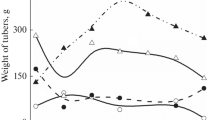Abstract
The effect of γ-radiation doses from 100 to 3000 kGy on the toxic properties and germination of oat seeds has been + studied. A tendency has been noted for a 15–25% decrease in the germination of oat seeds under laboratory conditions in the range of presowing irradiation doses of 10–700 Gy. After irradiation with a dose higher than 1 kGy, the seeds lost their ability to germinate. Curves reflecting the dependences of the length of oat stalk on the dose of presowing irradiation of seeds exhibited two areas with a characteristic separation point at doses of 70 Gy, below which the degree of influence of the irradiation dose on the height of seedlings and their growth ability increased noticeably. The toxicity of radiolyzed oat grains depended on the dose of γ-irradiation of grains and the mode of additional feeding of experimental mice. It was established that a γ-radiation dose lower than 100 kGy did not affect the toxicity of fodder oat grain, and radiation doses of 400 kGy or higher made irradiated grains unsuitable for feeding mice without additional feeding with compound feed. The higher the dose of γ-irradiation of oat grain, the earlier experimental mice died en masse: after 14–15, 9, 8, and 6 days of feeding at radiation doses of 580, 1000, 1700, and 3170 kGy, respectively. The reason for the toxic manifestation of irradiated oat grains and the death of mice treated with irradiated grain, apparently, can be the formation of toxic substances in oat grains irradiated with high doses due to the occurrence of physicochemical reactions in the course and after irradiation and a decrease in the nutritional value of products associated with the destruction of vitamins and other food components. Intoxication after consumption of oat grains irradiated with a dose of 400–3170 kGy was clinically manifested by depression, lethargy of animals, and signs of dehydration and diarrhea against the background of a strong decrease in the body weight of experimental animals. It is expedient to use radiolyzed oat grains for technical purposes, especially, if they were treated with high doses of radiation.






Similar content being viewed by others
REFERENCES
Koz’min, G.V., Sanzharova, N.I., Kibina, I.I., Pavlov, A.N., and Tikhonov, V.N., Dostizh. Nauki Tekh. APK, 2015, vol. 29, no. 5, p. 87.
Diehl, J.F., Safety of Irradiated Foods, New York: Marcel Dekker, 1995, 2nd ed.
Farkas, J., Irradiation of Dry Food Ingredients, Boca Raton, FL.: CRC, 1988.
Food Irradiation and the Chemist (Special Publication No. 86), Johnston, D.E. and Stevenson, M.H., Eds., Cambridge: Royal Society of Chemistry, 1990.
Chizh T.V., Koz’min G.V., Polyakova L.P., and Mel’nikova, T.V., Vestn. Ross. Akad. Estest. Nauk, 2011, vol. 1, p. 44.
Sanzharova, N.I., Geras’kin, S.A., Aleksakhin, R.M., Koz’min G.V., and Loi, N.N., Vestn. Ross. Akad. Estest. Nauk, 2013, vol. 1, p. 21.
Bradshaw, C., Kapustka, L., Barnthouse, L., Brown, J., Ciffroy, P., Forbes, V., Geras’kin, S., Kautsky, U., and Brechignac, F., J. Environ. Radioact., 2014, vol. 136, p. 98.
Aleksakhin, R.M., Geras’kin, S.A., and Udalova, A.A., Vestn. Ross. Akad. Nauk, 2015, vol. 85, p. 373.
Ul’yanenko, L.N. and Udalova, A.A., Byull. Nats. Radiat.-Epidem. Reg., 2015, vol. 24, p. 118.
Brechignac, F., Bradshaw, C., Carroll, S., Jaworska, A., Kapustka, L., Monte, L., and Oughton, D., Integr. Environ. Assess. Manag., 2011, vol. 7, p. 411.
Udalova, A.A., Geraskin, S.A., and Dubynina, M.A., Radiats. Biol.: Radioekol., 2012, vol. 52, p. 517.
Kiryukhin, D.P., Kichigina, G.A., Allayarov, S.R., and Badamshina, E.R., High Energy Chem., 2019, vol. 53, no. 3, p. 228.
Allayarov, S.R., Rudneva, T.N., Demidov, S.V., Allayarova, U.Yu., and Klimanova, E.N., High Energy Chem., 2022, vol. 56, no. 6, p. 429.
Litvyak, V.V., Batyan, A.N., and Kravchenko, V.A., Zh. Belarus. Gos. Univ.: Ekol., 2018, p. 62.
Korotchenko K.A. and Sharpatyi, V.A., Khim. Vys. Energ., 1993, vol. 27, no. 4, p. 50.
Sharpatyi, V.A., Raditsionnaya khimiya biopolimerov (Radiation Chemistry of Biopolymers) Moscow: Geos, 2008.
Sharpatyi, V.A., High Energy Chem., 2003, vol. 37, no. 6, p. 369.
Funding
This work was supported by a state contract no. АААА-А19-119041090087-4.
Author information
Authors and Affiliations
Corresponding author
Ethics declarations
COMPLIANCE WITH ETHICAL STANDARDS
All applicable international, national, and/or institutional guidelines for the care and use of animals were followed.
CONFLICT OF INTEREST
The authors declare that they have no conflicts of interest.
Additional information
Translated by V. Makhlyarchuk
Rights and permissions
About this article
Cite this article
Allayarov, S.R., Allayarova, U.Y., Klimanova, E.N. et al. Influence of High γ-Radiation Doses on the Germination and Toxic Properties of Oat Seeds. High Energy Chem 57, 132–139 (2023). https://doi.org/10.1134/S0018143923020029
Received:
Revised:
Accepted:
Published:
Issue Date:
DOI: https://doi.org/10.1134/S0018143923020029




